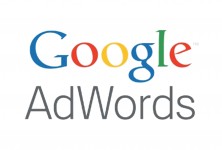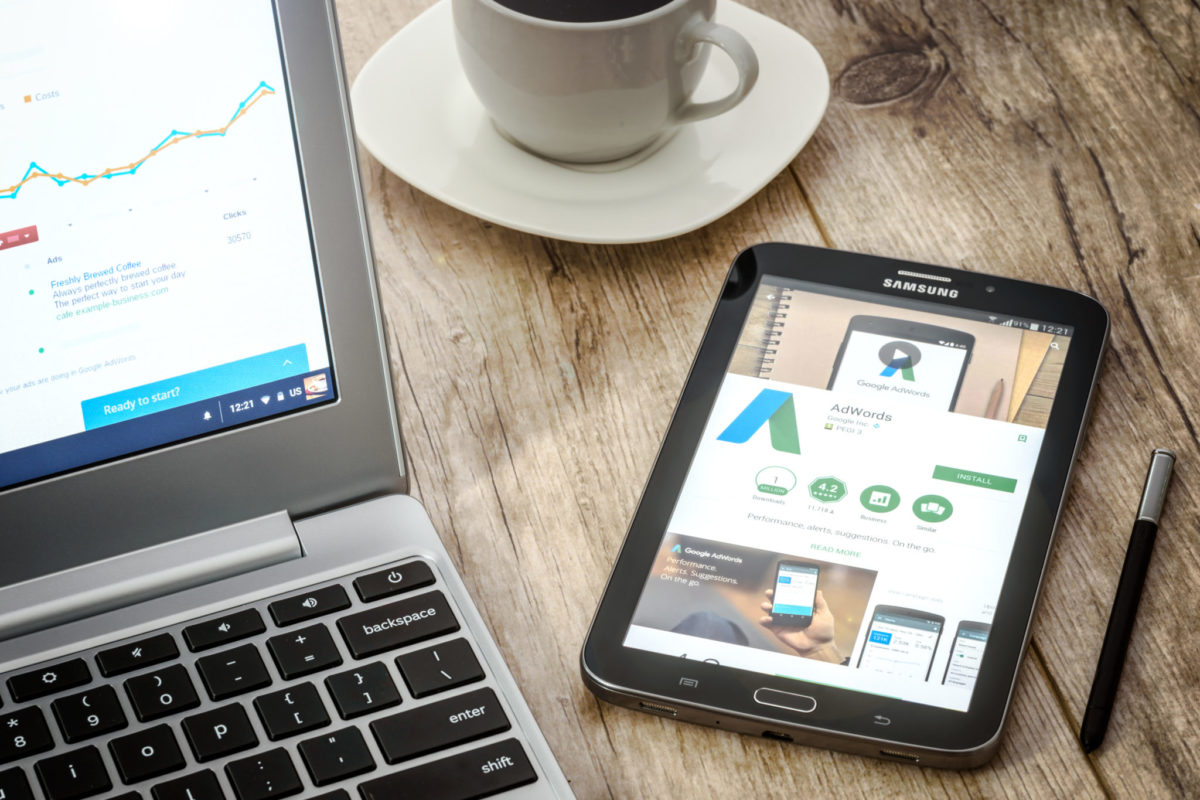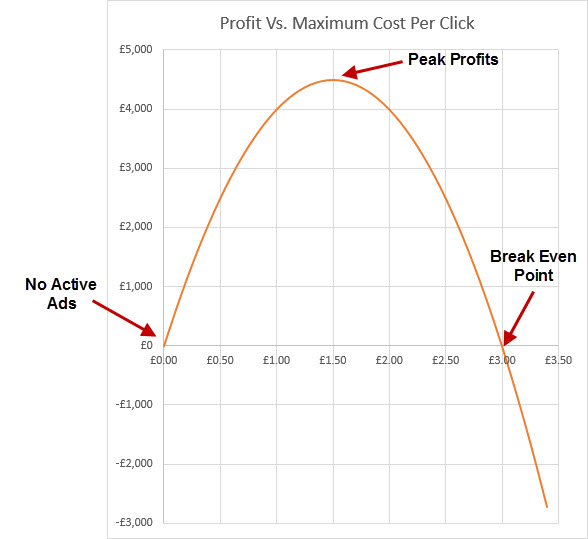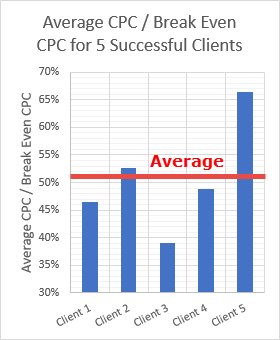 When advertising on paid platforms, such as Google Ads, you can control the maximum cost-per-click you are willing to pay for each keyword or display ad placement. There are several factors that determine how prominently your ads will show and how well your ad will perform.
When advertising on paid platforms, such as Google Ads, you can control the maximum cost-per-click you are willing to pay for each keyword or display ad placement. There are several factors that determine how prominently your ads will show and how well your ad will perform.
| Average CPC = Total Costs / Total Clicks |
Things you can control while performing paid advertising
- The maximum cost-per-click you are willing to spend to get a visitor to your website
- When or where your advert appears
- Which format your ad appears in (text, banner, video, shopping listing, etc.) and it’s content
- Which page of your website the advert will take people towards (the landing page)
- The cost of your products or services on the website (the perceived cost depending on quality and/or service)
- How the website works, looks and interacts with the visitors (how the website converts)
| Maximum CPC > Average CPC |
Things you cannot control while performing paid advertising
- The competition’s maximum cost-per-click amounts (this information is also hidden)
- The competition’s ad content
- The competition’s price for similar products or services
- The conversion rate of a competitor’s website
- The number of times your advert will appear for certain searches or topics (display or keyword traffic)
Calculating the ideal max CPC amount
After checking out your competition, you’ll need to be sure that you offer your product or service at a competitive price. Because there are likely to be a significant number of people searching for the product or service, you also need to ensure your website is in good shape, so it can convert visitors into customers. All other paid advertising factors are out of your control. The Max CPC values need to be based on YOUR website, YOUR prices and YOUR profit margins, then the advert will be shown at the appropriate ad position, which may be above or below your competitor’s ads.
Google’s calculation for the Actual CPC is based on your set Maximum CPC, Quality Score, and the Ad Rank of competitor ads. The video below cover the basics and explains how lowering your Maximum CPC can result in increased overall profitability:
Step 1 – work out what each sale or acquisition is worth to you in profit
When you gain a new customer, work out the average profit made from each new customer.
- Let’s say that you were selling cuckoo clocks online at £120 each and once tax, delivery costs and admin costs were subtracted there was £40 left over. In this case, each cuckoo clock sale is worth £40 in profit.
| Single Product Sale Profit = Product Revenue – Product Costs – Internal Costs – Tax |
- Let’s say you sold a monthly subscription to an online fishing magazine at $10/month and the average person kept their subscription for three months. This makes each subscription worth $30 on average.
| Average Lifetime Value Per Acquisition = Average Value Per Conversion x Average Number Of Repeat Conversions Per Customer |
- Let’s say that you worked as a painter and each new customer on average spent £400 and used you twice, on average. The costs for paint, tools, transport, and tax for each job comes up to £100 on average. Each new customer brings in profits worth: (£400 – £100) x 2 = £600
| Acquisition Profit = Average Lifetime Value Per Acquisition – Internal Costs – Tax |
Remember that whenever you are running an e-commerce website, or a lead generation website, there will be repeat customers and different costs involved. For e-commerce websites there will always be product costs alongside business costs on each sale. For lead generation websites, there might only be one set of upfront costs with relatively low costs for repeat customers. The important thing is to nail down an accurate profit-per-new-customer in each area of your business.
Step 2 – for lead generation websites only, figure out the number of leads required per conversion
Lead generation websites will naturally record calls, form submissions or other secondary goals to measure success instead of direct sales. For lead generation websites, it’s important to figure out the number of leads it takes to gain each new customer.
- Let’s say that you were selling £1,000,000 luxury holiday homes and counted each showroom visit request as a conversion. On average, it takes 2,000 separate groups of showroom visitors for each holiday home to be sold. This makes each conversion (lead) worth £1,000,000 / 2,000 = £500
| Average Value Per Conversion (Lead Gen.) = Average Sale Value / Average Number Of Leads To Make One Sale |
Step 3 – work out your current non-branded conversion rate
The conversion rate is the percentage of visitors that turn into customers. For example, if you make five sales from 100 visitors on average, your conversion rate is: 5 / 100 = 0.05 = 5%.
You may be able to look at existing non-branded PPC campaigns to get an idea of the current conversion rate or organic non-branded keyword reports if you only have search engine traffic data in Google Analytics. If you do accidentally include branded keywords then the conversion rate will appear much more favourable than it actually is, as people are far more likely to convert if they know the brand well. So make sure branded campaigns or keywords are filtered out.
If you have absolutely no conversion data, you need to setup up Ads conversion tracking, goal tracking or e-commerce tracking depending on your circumstances and wait for data to come in before completing this step.
| Average Conversion Rate = Total Number of Conversions / Total Number of Clicks |
Step 4 – work out the break-even CPC value
Now that we know what each conversion is worth and how many visitors it takes to make a conversion, we can then figure out the breakeven point where costs equal the profits.
Let’s say each conversion you made generated £10 worth of profit, each customer bought four items on average in their lifetime and on average you made 10 conversions for every 500 unique visitors, this gives:
- Conversion Rate = 10 / 500 = 0.02 = 2%
- Profit per Conversion = £10 x 4 = £40
Simply multiplying the profit per conversion with the conversion rate gives the break even cost per click amount. This is the exact amount you could pay for each visitor to a website and receive the same value back in return on average:
- Break Even CPC = 0.02 x £40 = £0.80
| Break-Even CPC = Average Conversion Rate x Average Profit per Conversion |
Step 5 – adjust for profitability and actual CPC amounts
It’s imperative that the Max CPC amount is set lower than the break-even CPC amount so that a profit will be made from each sale after advertising costs are considered.
If the Max CPC is set higher than the Break-Even CPC, this will result in a lot of conversions but overall each one will cost more in advertising revenue than it generates in profit, which will, therefore, result in an overall loss.
Lowering the max CPC amount too far will result in a higher return-on-investment (ROI) but a lower the number of sales overall. This is due to Google showing ads with a higher Ad Rank higher up in the results and ads that are higher up get more clicks on average.
Actual cost-per-click amounts tend to be a little lower than set Max CPC amounts as Actual CPCs are based on the Ad Rank of the advertiser below your ad. In our experience, this has a reduction of around 20%. For example, if you set a maximum cost-per-click value of $1.00 then you are likely to spend around $0.80 per click on average, around 20% less.
There is a sweet spot between breaking even and getting a good return-on-investment which can be optimised over time once a significant amount of clicks and sales have been made:
To hit the sweet spot, the bid should be approximately 70% of the Break-Even CPC bid amount (in real life, it’s a little more complex than the simplified graph shown above!). This reduction takes into account of the 20% difference mentioned earlier and places the ads in a profitable but competitive level.
| Ideal Max. CPC = Break-Even CPC x 0.70 |
Extracting recent data from our top five biggest spending successful clients (over 1 million clicks within the past 3 months) gives an average of 51% when measuring Average CPC divided by Break Even CPC, which represents a CPC reduction of 49%, a very close match to the rule. The bids are reduced by around 50% to make the ads profitable, while keeping them in a high enough ad position to get a good number of clicks (and therefore conversions) each day. The Max CPC needs to be set at around 20% higher to compensate for the actual CPC difference. The combination of these two changes is approximately 30% of the Break-Even CPC bid amount for the Ideal Max CPC, a multiplication of 0.7.
Maximum cost-per-click improvements
You may find that after adjusting keywords to the ideal maximum CPC level they are placed in a very low ad position. This may be due to Google Ads not yet assigning the correct quality score to each keyword, if it’s a new keyword or a keyword with a new advert. In this case, wait a day or two to see if the quality score improves. or sacrifice some profit and raise the ad positions to raise the number of clicks to around 75% of Break Even CPC.
The keyword quality score is directly related to Google’s basic Ad Rank measurement (Ad Rank = Keyword Quality Score x Max. CPC), so a lower quality score will place the ad in a lower position if the Max CPC stays the same.
Several improvements can be made to increase your target Max. CPC amount and therefore generate more profit per month including:
- Improving the quality score of keywords – As mentioned above, a better quality score results in cheaper advertising costs and can justify a higher Max CPC for a keyword. This is based on the relevancy of the keyword, the ad and its landing page. All three need to be in sync to achieve a high quality score.
- Improving the website to raise the conversion rate – Work on lowering the number of visitors needed to make a sale on average by making it easier and more attractive to buy on all devices. Most paid advertising accounts fail because the website simply has such a poor conversion rate so advertising is too expensive.
- Raising the profits per conversion – Prices can be raised, or business costs can be lowered to give a higher profit per conversion if possible. We have seen clients simply charge more for a service or product and the increase in profit per conversion has outweighed the impact on conversion rates allowing bids to be raised to get more sales per day.
- Using Ad Extensions or other methods to take up more space within the ads – Ad extensions also now play a key part in quality score. If you don’t use them Google will slightly raise the advertising costs per click.
- Getting enough reviews for star ratings on Google Ads – Part of the quality score calculation is the click-through-rate of the ads and you can improve this by working towards 150+ good seller ratings on a review website.
- Using bid adjustments to spend less budget on lower converting locations, times or devices and more budget on the better converting locations, times or devices.
Changing max CPC based on cost-per-acquisition (CPA) and return-on-ad-spend (ROAS) targets
The process of finding the right Max CPC bid level can be simplified if you stick to a set cost-per-conversion (cost-per-acquisition) target for a lead generation website, or a return-on-ad-spend target for ecommerce PPC campaigns.
Cost-per-acquisition target (Lead Generation Websites)
The CPA target is basically the amount you are willing to pay for each conversion on your website. It can be combined with the conversion rate to give an Ideal Max. CPC value. A 20% boost is given for the difference between the Max CPC and the Actual CPC:
- Let’s say that you were a local emergency plumber and you are willing to pay Google $20 for each phone call you receive from people looking for an emergency plumber. If your website needs on average 10 people to view before one calls you, the CPA target is £20 and the Conversion rate = 1/10 = 0.1 = 10%. The Ideal Max CPC = 20 x 0.1 x 1.2 = $0.24
| Ideal Max. CPC (lead gen) = CPA Target x Average Conversion Rate x 1.2 |
Return-on-ad-spend target (ecommerce websites)
The ROAS target is the relationship between product revenue and advertising costs that you are willing to accept. Calculated as the revenue generated from product sales divided by costs from the paid ads:
| ROAS = Total Product Revenue / Total Advertising Costs |
Naturally, most advertisers want to spend as little as possible on advertising. They wish to maintain a high ROAS. To raise the ROAS you need to lower the bids to make more profit per sale. Raising the ROAS target too high can result in non-competitive bids which generate very few sales per day, so a balance must be found.
Our clients have a range of different ROAS targets which depend on the profit made in each sale online. Big ticket items such as self-made furniture need a ROAS value of around 4.0 to get the right balance of profit per sale and the number of sales per day. Selling products from other manufactures may require an ROAS of around 7.0 to account for the percentage of profit lost per sale by the manufacturer. Drop-shipping products ads are often highly competitive and require an ROAS target of around 12.0 to account for the low profits of being the cheapest seller online and the percentage of profits paid to the product suppliers.
The Ideal Max. CPC needs to be based off the previous ROAS performance which takes into account the revenue and cost relationship, as well as the average CPC of the account in that time period. A 20% boost is given for the difference between the Max CPC and the Actual CPC:
- Let’s say that you sold garden gnomes online and wanted to get £7 for every £1 spent on advertising. Previously, you’ve got back only £5 for every £1 spent on advertising, when the average cost per click has been £0.60. Therefore, the ROAS target is 7.0, the Average CPC is £0.60 and previously the Average ROAS was 5.0. The Ideal Max. CPC = £0.60 x (5 / 7) x 1.2 = £0.51
| Ideal Max. CPC (ecommerce) = Average CPC x (Average ROAS / Target ROAS) x 1.2 |
Conclusion
You can’t control the Max CPC bids and quality scores of other advertisers but you can place your ads in at a level where they will be profitable at your own ideal Max CPC. The factors which could be holding back profits possibly includes the conversion rate of the website, the product/service price, or the quality score of the keywords.
The basic formula for working out the ideal Max CPC amount for a keyword is:
| Ideal Max. CPC (highest profits) = Average Conversion Rate x Average Profit per Conversion x 0.70 |
| Ideal Max. CPC (set CPA) = CPA Target x Average Conversion Rate x 1.2 |
| Ideal Max. CPC (set ROAS) = Average CPC x (Average ROAS / Target ROAS) x 1.2 |
Ideal Max CPC Examples
Example 1
Average Profit per Conversion = £25.00
Average Conversion Rate = 2.0% (2 sales for every 100 clicks) = 0.02
Ideal Max. CPC (highest profits) = 25.00 x 0.02 x 0.7 = £0.35
Example 2
CPA Target = $80.00 Per Lead (willing to spend $80.00 for each lead)
Average Conversion Rate = 15% (15 leads for every 100 clicks) = 0.15
Ideal Max. CPC (set CPA) = 80.00 x 0.15 x 1.2 = $14.40
Example 3
ROAS Target = 12 (aiming to get £12 for every £1 spent)
Average ROAS = 6 (currently getting £6 for every £1 spent)
Average CPC = £0.20 (currently spending £0.20 per click)
Ideal Max. CPC (set ROAS) = 0.20 x (6 / 12) x 1.2 = £0.12
How To Calculate The Ideal Maximum CPC for Ads https://t.co/llP7u6hSyz #ppcchat
— Jonathan Ellins (@Jonathan_Ellins) March 7, 2017





